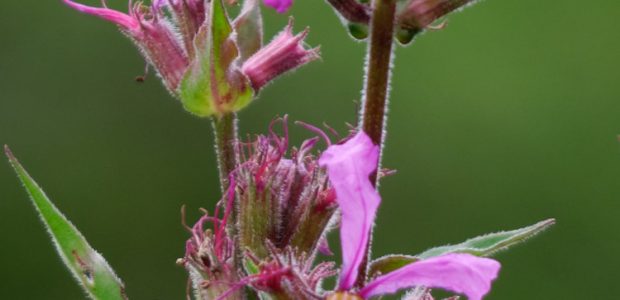![]() This is featured in Issue #5 of The Luminous Landscape Video Journal
This is featured in Issue #5 of The Luminous Landscape Video Journal
This page is the first of two a two-part commentary on and review of the Canon EOS D60.
The other segment is acomparisonof the D60 with the D30 and with Medium Format.
Both should be read together for a complete picture of what I think about this camera.
An article onmacro-butterflyphotography also forms part of this report.
Late to The Party
Due to a series of misadventures and timing difficulties it was about a month after the Canon EOS D60 was first released in March, 2002 that I finally obtained a loaner from Canon for review. For this reason, as well as because the camera is so similar to the already familiar D30, I decided that rather than conduct a comprehensive review I would do a report in two parts‚ a comparison with the medium format, and a field report along with a small portfolio of images that display some of the camera’s capabilities.
I had spent a day doing some controlled tests and comparisons with a couple of medium format cameras as well as the D30, but I was eager to actually do some some real-world shooting with the D60. This is the only way I know of to really come to terms with what a new camera is all about.
In the Wet
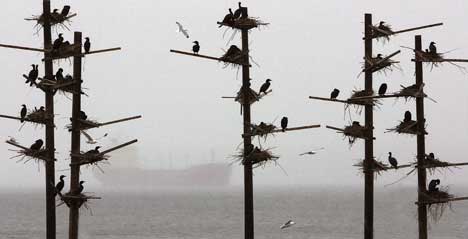 Bird Condo, Hamilton‚ April, 2002
Bird Condo, Hamilton‚ April, 2002
Photographed with a Canon EOS D60 and 70-200mm f/2.8L IS zoom @ ISO 400
This bizarre stand of clearly artificial roosts sits at the edge of an industrial harbour.
The birds enjoy a view of freighters sailing past through the fog. Hi-rise condo living for the birds.
While the spring weather in Ontario had been quite warm and beautiful, during the days that I had to conduct this field report it rained. Well, it didn’t just rain‚ it poured. No, it didn’t just pour‚ there were also thunderstorms and heavy fog, combined with tornado warnings.
Nevertheless, I headed out for a couple of days shooting in Ontario’s Niagara Peninsula, a lovely agricultural region that in late April saw its fruit trees in full blossom‚ifyou could see them through the fog and rain. But my attitude is that there is no such thing as bad weather for landscape and nature photography, so we pressed on through the storm.
The drive to Niagara from Toronto takes one past the steel-making city of Hamilton, a gritty place made all the more so that day by the dense fog and driving rain. Out of curiosity, as well as a desire to get off the expressway because of the nasty weather, we drove down to the city’s industrial harbour.
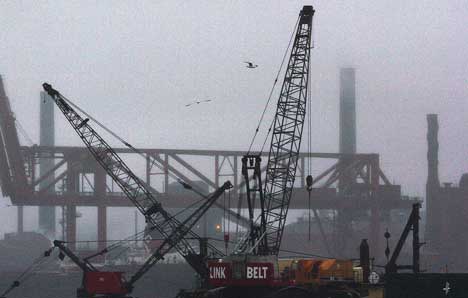 Steel Mill Gulls, Hamilton‚ April, 2002
Steel Mill Gulls, Hamilton‚ April, 2002
Photographed with a Canon EOS D60 and 70-200mm f/2.8L IS zoom @ ISO 400
This frame, like the one preceding it, was shot in dense fog and rain. It’s worth looking at enlarged (click on the picture) because it was shot accidentally 3 stops underexposed. I had rotated the exposure compensation dial and not noticed it until after shooting several frames.
In my earlier testing I had been impressed with how well the D60 was able to hold shadow detail. So even though the original frame was almost completely black, I loaded it into Photoshop from BreezeBrowser in 16 bit mode to see what could be salvaged. Surprisingly, quite a bit. Yes, it’s grainy, but in fact the grain is so pronounced that it takes on the look of a pointillist painting. If this had been transparency film there is no way that I could have even printed it. It simply would have been too dense. Impressive performance by the D60.
Image Quality
My evaluation of the D60’s image quality is summarized in my companion articlecomparingit with medium format. As you will likely have read by now I find the D60’s output to equal that from high-quality film scans (as I did those of the D30), except that now one can make prints on full A3 (11X17") sized paper, without having to resort to ressing-up, or the use ofGenuine Fractals.
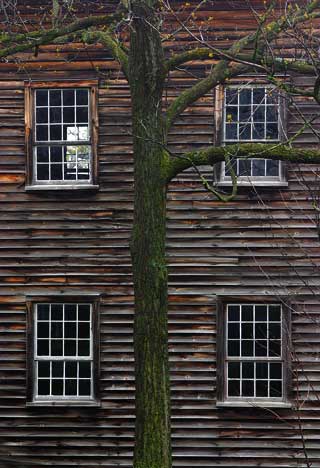 Balls Falls, Niagara‚ April, 2002
Balls Falls, Niagara‚ April, 2002
Photographed with a Canon EOS D60 and 70-200mm f/2.8L IS zoom @ ISO 400
A study in textures and detail such as this tree and wet weathered board on a 19th century building would not have fared well with the D30. My preferred set-up would have been to use medium format so as to adequately capture the fine detail that makes this study so interesting. The D30 would simply not have been up to the job in anything larger than a 6X9" print, which wouldn’t have been sufficient to do justice to the subject.
Shooting with the D60 I was able to make a 9 X 15" print that at first glance might be mistaken for medium format, even though it was taken at ISO 400. A closer examination would cause a person with an experienced eye to conclude that the shot was likely 35mm, but even then‚ really well-executed 35mm.
A Matter of Technique
In early 2002 I wrote an article titledLens Sharpness‚ The Never Ending Quest. In it I explored the issue of what it takes to achieve really sharp images, and concluded that even modest lenses are usually better than the technique used by most photographers.
This applies in spades to the Canon D60. The image quality that it is capable of producing is likely to be limited more by the ancillary equipment and technique used by photographers rather than by any deficiencies of the D60’s imaging chip.
This camera really makes demands of the lenses placed on it. With the D60, Canon’s "L" series glass is really called upon to extract maximum image quality, as will be the photographer’s use of a solid tripod, appropriate shutter speed etc., so that none of these is the weak link in the chain. It’s my belief, after some use of the D60 with several "L" series lenses as well as a couple of consumer grade ones (like the 28-135mm), that only the best glass combined with the best technique will show what this camera can really do.
Cruising the Blossoms
We drove for hours through the fruit orchards of the Niagara Peninsula. Again we were stymied by fog and rain. I really wanted to be able to show the D60 at its best‚ ISO 100, impeccable technique and hopefully some strong images.
It was not to be. Stepping out of the car meant getting soaked, even though we were dressed in full rain gear. Consequently there are fewer worthwhile outdoor frames to illustrate the article than I would have wished.
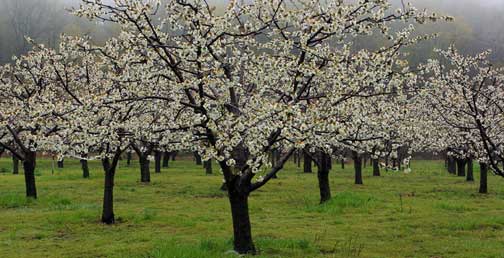 Blossoms 56, Niagara Peninsula‚ April, 2002
Blossoms 56, Niagara Peninsula‚ April, 2002
Photographed with a Canon EOS D60 and 28-70mm f/2.8L zoom @ ISO 400
Because of the day’s heavy overcast, light levels were low, and so almost every frame shot was at ISO 400. This frame is typical of the rich colour saturation produced by the rain. The D60 follows in the heels of its progenitor, the D30, in capturing such saturated colours with intensity yet purity.
It’s the Colour Stupid
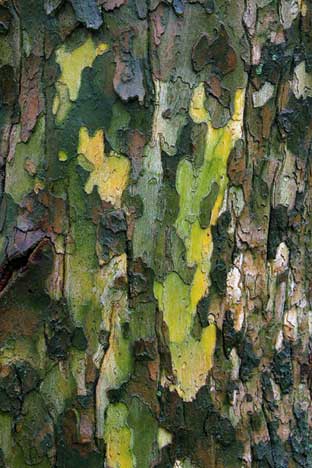 Bright Bark, Niagara‚ April, 2002
Bright Bark, Niagara‚ April, 2002
Photographed with a Canon EOS D60 and 70-200mm f/2.8L IS zoom @ ISO 400
Like the D30 before it, one of the Canon D60’s sterling capabilities is its colour rendition. There is a purity and a saturation to the colours (notice I writepurity ‚ not necessarilyaccuracy) that I’ve never seen from from any other system, including other digital cameras and backs.
Whatever it is, whether it’s the use of Canon’s proprietary CMOS imaging chip or magic pixie dust, I like what it does. And, when you combine this with the D60’s more-than-adequate resolution and file size, you have the makings of a very fine picture-taking machine indeed.
Bits to Spare
After 18 months of working with the Canon D30, switching to the D60 produced one overwhelming impression‚ there was now enough image data for a reasonable amount of cropping. Unlike some photographers, who have an almost religious fixation on only printing what the camera has captured, and not a smidge less, I crop my prints to an aspect ratio or portion of the frame that suits the subject. I don’t let the fact that because Oscar Barnack decided in 1926 that a 35mm frame should be the shape that it is, or because I couldn’t get close enough at the time of shooting, restrict me in any way.
But, because the D30 only produces a 6 X 9" file, at a printer resolution of 240 ppi, there isn’t much to work with. The 20-40MB size of a scanned 35mm frame is much more amenable to cropping, not to mention the even greater freedom that working in medium format affords. Now, with the D60, there is an original 18MB file to work with, and it makes a huge difference not only in the ultimate size that a full frame can be printed but also the amount of cropping that can be done.
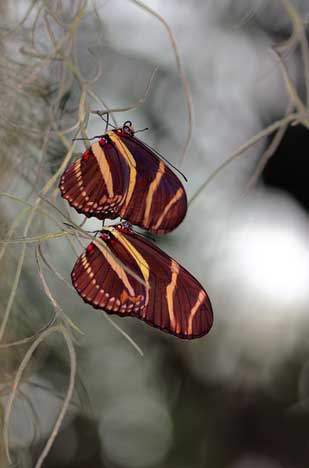 2 Butterflies, Niagara Ontario‚ April, 2002
2 Butterflies, Niagara Ontario‚ April, 2002
Canon EOS-D60 and Canon 100mm f/2.8 Macro USM with MR14EX Ring Lite. ISO 400
Price
While not yet under the magic $1,000 price point, at just $2,000 the D60 is an incredible bargain. This cost is a third less then the price of a D30 just a year ago, and this for a camera which produces a high-quality image twice the size of that from its older sister.
If you’ve been waiting for the price of a digital SLR to reach affordability, depending on your means you might well find that the time is here.
Thanks for the Memories
A D30 using a 1GB Microdrive can take 289 RAW-mode frames. That’s the equivalent of 8 rolls of film‚ as much as most photographer will need on a busy shooting day, or even a weekend.
The D60 with its much larger file size can take just 141 frames, or the equivalent of only 4 rolls. I was made aware of this when in the middle of shooting at the Butterfly Conservatory I found that I was running low on frames even though it hadn’t been a busy shooting day.
I’d say that 2 Microdrives are now a minimum for a busy day in the field. Let’s hope that IBM ships a 5GB Microdrive soon.
Strengths & Weaknesses
Canon D30 owners, or those who have done their research, will know what that camera’s strengths and weaknesses are. The D60’s are essentially the same. On the plus side of the ledger are great image quality, superb battery life, and freedom from dust on the image sensor (something that plagues many other DSLRs). The frame buffer has also been increased in size over the D30 from 3 to 8 for RAW files.
The negatives include substandard autofocus, consumer-grade build quality, and slow frame rates. Of course the 1.6X magnification factor is an impediment to much wide angle work.
TheCanon EOS 1Daddresses most of these concerns, but at a much higher cost, and with a smaller output file size than the D60. Battery life and sensitivity to dust on the sensor are not among the problems addressed by the 1D.
What Should You Do?
So, it’s crunch time. What should you do? Of course it depends on a number of variables, but since regular readers know that I don’t pull punches‚ here’s my opinion, and some thoughts on whatI’mgoing to be doing.
If You Already Have a D30
If you love your D30 but only wish that it produced bigger image files then getting a D60 is a no-brainer. It has all the features and capabilities that you love (and hate), along with a big fat 18Mb file size.
If You Currently Own Canon Lenses
If you already own Canon lenses and are thinking about making the move to a digital SLR I’d say that the time has come. Image quality is every bit as good as that from high-quality film scans, and this is now the case at just about any print size you’d care to make. And, when you factor in the convenience, operating cost savings as well as increased versatility that digital offers, the D60 is a compelling buy.
If You’re Not Committed to Canon
For a Canon lens and accessory owner the choice is clear. Either get a D60 now or wait for the next generation. If money isn’t a factor and you’re in no hurry a six month wait for Canon’s next pro-level DSLR will offer certain advantages.
But what if you currently own another brand of camera? As good as the D60 is, I wouldn’t recommend that anyone switch brands because of it. Nikon and Fuji have comparable cameras coming out in the next few months, both of which will take Nikon mount lenses. The Sigma SD9 using the much-touted Foveon chip is coming soon, though why anyone would buy a camera like this and be limited to using Sigma lenses is beyond me.
Owners of other brands whose makers have not yet entered the DSLR fray may want to give serious thought to the D60 though. Canon’s lens line is both broad and deep, and if there’s a camera accessory that Canon doesn’t make then someone else likely does. Now may well be a good time to make the move to digital along with the switch to Canon.
My Plan
I use medium format equipment for most of my work. I live with the format’s limitations in exchange for the highest image quality possible given the way I work when out in the field. I use 35mm gear when I need autofocus, very long or very wide lenses or for any of the other advantages that the smaller format offers. I use digital (currently the D30) when its particular advantages are clear.
But, now that the Canon D60 is upon us, the equation is changing. One can (almost) have medium format image quality along with 35mm’s advantages,anddigital’s convenience.
UPDATE: Summer, 2002
I have now bought a D60. I was planning on waiting for the anticipated next-generation pro model from Canon, almost certain to be announced at Photokina in September. But after testing the D60, my D30 no longer satisfied. When the 1Ds (or whatever it’s called) appears, it together with the D60 as backup will serve as my 35mm SLR system, and I’ll retire my EOS 1V.
This page is the first of two a two-part commentary on and review of the Canon EOS D60.
The other segment is acomparisonof the D60 with the D30 and with Medium Format.
Both should be read together for a complete picture of what I think about this camera.
An article onmacro-butterflyphotography also forms part of this report.
![]() This is featured in Issue #5 of The Luminous Landscape Video Journal
This is featured in Issue #5 of The Luminous Landscape Video Journal
You May Also Enjoy...
Steptoe Butte 3
With the Grain© Miles HeckerCLICK ABOVE IMAGE TO SEE GOOGLE MAP LOCATION SEASONS The best time to shoot the Palouse is when things are green
A Tale of Two Fujis Part I – Introduction and the GFX 100
FacebookTweet Fujifilm is one of the most interesting players in the camera market in early 2020. They always march to their own drum – skipping
